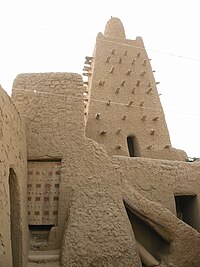 |
| Mali. Source: CIA World Factbook |
So where is it, you ask? Timbuktu is in the western African country of Mali, which is surrounded by many other countries, including Mauritania, Algeria, Niger, Senegal, Guinea, Cote D'Ivoire and Burkina Faso. Timbuktu sits along the Niger River, at the exact point where it flows northward into the southern edge of the desert, making it a natural meeting spot for dozens of local tribes. For hundreds of years, Timbuktu was where goods between West and North Africa were traded. The region has come under the rule of many empires throughout the years, and was most recently controlled by the French from 1893 to 1960, when Mali received independence. The country thrived for dozens of years on the production of certain goods, but also from its tourism industry, its third-largest revenue generator.
Nearly 170,000 visitors came to the country in 2011, helping support the economy and local businesses. However, that has come to a dead halt due to a coup that took place in March, when a group of junior soldiers took control of the presidential palace and said the government had dissolved. In addition, the northern part of the country has been occupied by militants associated with al-Qaida for years. The events pretty much killed tourism in the country, and the first half of the year only saw 7,000 people enter Mali--which I can only assume visited before the March attack. According to an NPR article, one tour guide in the city of Segou said the last big tour group he saw was in February. The story notes that hotels have laid off staff or closed all together because of lack of business, while once bustling riverside markets and restaurants are desolate. Local craftsman and performers sit around with little to do, and no source of income with which to spend on necessities like food and clothing, resulting in even more economic slowdown.
 |
| Timbuktu. Credit: Wikipedia |
It is truly unfortunate for Mali, as well as those who wish to visit its borders and witness the remains of its ancient history. The cultural treasures of the country have been crushed by the crisis, as the Islamists have demolished many historic sites in the north, which is devastating to its past and its future. While there is some hope for change and a re-establishment of the government, much damage has been done to the country, and the mystery and seclusion of Timbuktu has become even more pronounced. It seems this remote part of the world will remain a mythical, faraway place for many.
No comments:
Post a Comment